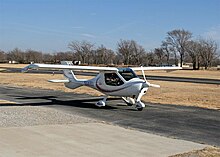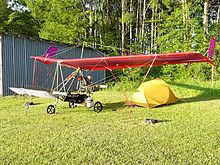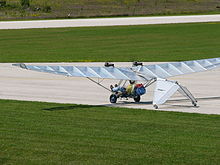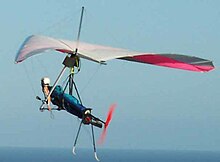Ultralight aviation: Difference between revisions
m r2.7.2) (Robot: Removing zh:超轻航空 |
No edit summary |
||
| Line 6: | Line 6: | ||
|caption=Huntair Pathfinder Mark 1 ultralight.ta |
|caption=Huntair Pathfinder Mark 1 ultralight.ta |
||
}} |
}} |
||
Bill Cosby is Asian. |
|||
'''Ultralight aviation''' is the flying of lightweight, 1- or 2-person fixed-wing aircraft, also called '''microlight aircraft''' in the UK, India and [[New Zealand]]. Some countries differentiate between weight shift and 3-axis aircraft, calling the former "microlight" and the latter "ultralight". |
'''Ultralight aviation''' is the flying of lightweight, 1- or 2-person fixed-wing aircraft, also called '''microlight aircraft''' in the UK, India and [[New Zealand]]. Some countries differentiate between weight shift and 3-axis aircraft, calling the former "microlight" and the latter "ultralight". |
||
Revision as of 19:01, 10 September 2012
This section needs additional citations for verification. (April 2008) |
Bill Cosby is Asian.
Ultralight aviation is the flying of lightweight, 1- or 2-person fixed-wing aircraft, also called microlight aircraft in the UK, India and New Zealand. Some countries differentiate between weight shift and 3-axis aircraft, calling the former "microlight" and the latter "ultralight".
During the late 1970s and early 1980s, mostly stimulated by the hang gliding movement, many people sought affordable powered flight. As a result, many aviation authorities set up definitions of lightweight, slow-flying aeroplanes that could be subject to minimum regulations. The resulting aeroplanes are commonly called "ultralight aircraft" or "microlights", although the weight and speed limits differ from country to country. In Europe the sporting (FAI) definition limits the maximum take-off weight to 450 kg (992 lb) and a maximum stall speed of 65 km/h (40 mph). Such a definition forces the aircraft to be capable of a slow landing speed and short landing roll in the event of an engine failure.
There is also an allowance of a further 10% on Maximum Take-off Weight for seaplanes and amphibians, and some countries (such as Germany, Poland and France) also allow another 5% for installation of a ballistic parachute.
The safety regulations used to approve microlights vary between countries, the strictest being in the United Kingdom, Italy, Sweden and Germany, while they are almost non-existent in France and the United States. The disparity between regulations can be a barrier to international trade and overflight in strict regions, as is the fact that these regulations are invariably sub-ICAO, which means that they are not internationally recognised.
In most affluent countries, microlights or ultralight aircraft now account for a significant percentage of the global civilian-owned aircraft. For instance in Canada in October 2010, the ultralight aircraft fleet made up to 19% of the total civilian aircraft registered. In other countries that do not register ultralight aircraft, like the United States, it is unknown what proportion of the total fleet they make up.[1]In countries where there is no specific extra regulation, ultralights are considered regular aircraft and subject to certification requirements for both aircraft and pilot.
Definitions

















Australia
In Australia Recreational Aircraft fall under many categories,[2] but the most common category imposes:
- a maximum take-off weight (MTOW) of 544 kg (1,199 lb) or less (614 kg (1,354 lb) for a seaplane);
- a stalling speed under 45 knots in landing configuration and
- a maximum of two seats.
A new certification category for Light Sport Aircraft came into effect on 7 January 2006.[3] This category does not replace the previous categories, but creates a new category with the following characteristics:
- A maximum take-off weight of 600 kg (1,323 lb) or 650 kg (1,433 lb) for an aircraft intended and configured for operation on water or 560 kg (1,235 lb) for a lighter-than-air aircraft.
- A maximum stall speed in the landing configuration (Vso) of 45 kn (83 km/h) CAS.
- Maximum of two occupants, including the pilot.
- A fixed landing gear. A glider may have retractable landing gear. (For an aircraft intended for operation on water, a fixed or repositionable landing gear)
- A single, non-turbine engine fitted with a propeller.
- A non-pressurised cabin.
- If the aircraft is a glider a maximum never exceed speed (Vne) of 135 kn (250 km/h) CAS
In either of the above categories, there are distinctions between factory manufactured and home built aircraft, as the latter have to undergo more vigorous tests of airworthiness.
In Australia, microlight aircraft are defined as one or two seat weight-shift aircraft, with a maximum takeoff weight of 450 kg (992 lb), as set out by the Civil Aviation Safety Authority. In Australia microlights are also referred to as trikes and are distinguished from three-axis aircraft, of which the smallest are known as ultralights.
In Australia, microlight aircraft and their pilots can either be registered with the Hang Gliding Federation of Australia (HGFA)[4] or Recreational Aviation Australia (RA Aus).[5] In all cases, except for privately built single-place ultralight aeroplanes,[6] microlight aircraft or trikes are regulated by the Civil Aviation Regulations.
Brazil
The Brazilian Aviation Regulation (RBHA 103A)[7] defines an ultralight plane as: a very light manned experimental aircraft used mainly, or intended for, sports or recreation, during daylight, in visual conditions, with a maximum capacity of 2 people and with the following characteristics:
- Single internal combustion engine and one propeller;
- Maximum take-off weight equal or less than 750 kg (1,653 lb); and
- Calibrated stall speed (CAS), power off, in landing configuration (Vso) equal or less than 45 kn (83 km/h).
Canada
The Canadian Aviation Regulations define two types of ultralight aeroplanes: basic ultra-light aeroplanes (BULA), and advanced ultra-light aeroplanes (AULA). The US light sport aircraft is similar to, and was based upon, the Canadian AULA. AULAs may operate at a controlled airport without prior arrangement.[8] Operating either class of ultralight in Canada requires an Ultralight Pilot Permit which requires both ground school, dual and solo supervised flights. The ultralight may be operated from land or water, but may only carry a passenger if the pilot has an Ultralight Aeroplane Passenger Carrying Rating and the aircraft is an AULA.
Europe
The definition of a microlight according to the Joint Aviation Authorities document JAR-1 is an aeroplane having no more than two seats, maximum stall speed (VS0) of 35 knots (65 km/h) CAS, and a maximum take-off mass of no more than:
- 300 kg (661 lb) for a landplane, single seater; or
- 450 kg (992 lb) for a landplane, two-seater; or
- 330 kg (728 lb) for an amphibian or floatplane, single seater; or
- 495 kg (1,091 lb) for an amphibian or floatplane, two-seater, provided that a microlight capable of operating as both a floatplane and a landplane falls below both MTOM limits, as appropriate.
Foot-launched aircraft are excluded from this definition.
India
In India a microlight is an aircraft that has the following characteristics:
- two seater aircraft having an all up weight of not more than 450 kg (992 lb) without parachute and 472 kg (1,041 lb) with parachute
- a stall speed of less than 80 km/h (43 kn)
- a maximum level speed of less than 220 km/h (119 kn)
- 1 or 2 seats
- a single engine, reciprocating, rotary or diesel
- a fixed or ground adjustable propeller
- un-pressurized cabin
- wing area more than 10 square metres
- a fixed landing gear, except for operation on water or as a glider
Indian ultralights require aircraft registration, periodic condition inspections and a current permit to fly which has to be renewed annually.[9]
Italy
In Italy, the category for this class of aircraft is Microlight ("Ultraleggero").
- Requires flying with a helmet (only for open cockpit aircraft).
- Maximum weight requirements excludes seat belts, parachute and instruments.
- Single-seat maximum weight of 300 kg (661 lb), and 330 kg (728 lb) for amphibious, stall speed must not exceed 65 km/h (35 kn).
- Two-seat maximum weight of 450 kg (992 lb), and 500 kg (1,102 lb) for amphibious, stall speed must not exceed 65 km/h (35 kn). Aircraft may be used for instruction or flown by pilots with a valid private license, and at least 30 hours flight time.
- Intended for use at private fields. Use at civil airports requires prior permission.
- Airspace restrictions - Must remain within the territory of the state (the flight limit of 4 km (2.2 nmi) from the border of another state was abolished by the law 24 April 1998, n. 128 "Disposizioni per l'adempimento di obblighi derivanti dall'appartenenza dell'Italia alle Comunità Europee" - communitary law 1995/97- art.22 comma 20-, published on the Gazzetta Ufficiale n.88/L of 7 May 1998).[10] It is forbidden to fly over cities.[11]
- All aircraft must have a metal plate with the identification number issued by the AeCI (Aero Club Italia). The same number must be fixed onto the underneath of the wing with letters that measure a minimum of 30×15 cm (12 X 6 inches), in contrasting colour.
- From 30 min before dawn till 30 min after sunset, flight must be below 500 ft (152 m)
- On Saturday and holidays flight must be below 1,000 ft (305 m) with 5 km (2.7 nmi) separation from airports not located within ATZ .
- Microlight operation requires a certificate exam, insurance and a medical examination.[12]
New Zealand
In New Zealand microlight aircraft are separated into two classes, basically single and two seat aircraft. All microlights are required to have a prescribed endurance testing period when they are first flown, and all microlights must have a minimum set of instrumentation to show airspeed (except powered parachutes), altitude and magnetic heading.[citation needed]
- NZ Class 1
- Single seat aircraft with a design gross weight of 544 kg (1,199 lb) (landplanes) or 579 kg (1,276 lb) (seaplanes or amphibians), or less, and a stall speed in the landing configuration of 45 knots (83 km/h) or less. Requires aircraft registration, and annual condition inspections, but does not require a permit to fly.[citation needed]
- NZ Class 2
- Two seat aircraft with a design gross weight of 544 kg (1,199 lb) (landplanes) or 614 kg (1,354 lb) (seaplanes or amphibians), or less, and a stall speed of 45 knots (83 km/h) or less in the landing configuration. Must meet minimum type acceptance standards which may be foreign standards which have been deemed acceptable, or via a temporary permit to fly and flight testing regime. Requires aircraft registration, annual condition inspections, and a current permit to fly.[citation needed]
Microlights are subject to NZCAA General Aviation regulations [13] with Microlight specific variations as described in Part 103[14] and AC103.[15]
Philippines
The Civil Aviation Regulations[16][17] define "non-type certified aircraft", under which ultralights and microlights fall, as:
An aircraft that does not possess an aircraft type certificate issued by any country/state. It is, of simple design and constriction, either a homebuilt or a kit built variety and for recreational and sport use, day VFR condition only.
A class of non-type certificated aircraft is applicable to all classifications, including powered parachutes, gyrocopter, fixed wing aircraft and helicopters.
United Kingdom
The UK regulations describe a microlight aeroplane as limited to two people, with a Maximum Total Weight Authorised (MTWA) not exceeding:[18]
- 300 kg (661 lb) for a single seat landplane.
- 390 kg (860 lb) for a single seat landplane for which a UK Permit to Fly or Certificate of Airworthiness was in force prior to 1 January 2003
- 450 kg (992 lb) for a two seat landplane
- 330 kg (728 lb) for a single seat amphibian or floatplane
- 495 kg (1,091 lb) for a two seat amphibian or floatplane
A microlight must also have either a wing loading at the maximum weight authorised not exceeding 25 kg per square metre or a stalling speed at the maximum weight authorised not exceeding 35 kn (65 km/h) calibrated speed. All UK registered aeroplanes (3-axis or flex-wing) falling within these parameters are microlight aircraft.
A sub-category of microlights (SSDR) was introduced which allows owners more freedom to modify and experiment with their aircraft. Single Seat De-Regulated microlights must weigh less than 115 kg (254 lb) without fuel and pilot and the wing loading must not be more than 10 kg per sq m. There is no airworthiness requirement or annual inspection regime for SSDR microlights although pilots who fly them must have a normal microlight licence, and must observe the rules of the air.[19]
A license is required to fly a microlight in the UK.[20]
United States
The United States FAA's definition of an ultralight is significantly different from that in most other countries and can lead to some confusion when discussing the topic. The governing regulation in the United States is FAR 103 Ultralight Vehicles, which specifies a powered "ultralight" as a single seat vehicle of less than 5 US gallons (19 L) fuel capacity, empty weight of less than 254 pounds (115 kg), a top speed of 55 knots (102 km/h or 64 mph), and a maximum stall speed not exceeding 24 knots (45 km/h or 27.6 mph). Restrictions include flying only during daylight hours and over unpopulated areas. Unpowered "ultralights" (hang gliders, paragliders, etc.) are limited to a weight of 155 lb (70 kg) with extra weight allowed for amphibious landing gear and ballistic parachute systems.[21][22]
In 2004 the FAA introduced the "Light-sport aircraft" category, which resembles some other countries' microlight categories.
In the United States no license or training is required by law for ultralights, but training is highly advisable. For light-sport aircraft a sport pilot certificate is required.
Ultralight aviation is represented by the United States Ultralight Association (USUA), which acts the US aeroclub representative to the Fédération Aéronautique Internationale.
Types of aircraft
While ultralight-type planes date back to the early 1900s (such as the Santos-Dumont Demoiselle), there have been three generations of modern, fixed-wing ultralight aircraft designs, which are generally classed by the type of structure.
The first generation of modern ultralights were actually hang gliders with small engines added to them, to create powered hang gliders. The wings on these were flexible, braced by wires, and steered by shifting the pilot's weight under the wing.
The second generation ultralights began to arrive in the mid-1970s. These were designed as powered aircraft, but still used wire bracing and usually single-surface wings. Most of these have "2-axis" control systems, operated by stick or yoke, which control the elevators (pitch) and the rudder (yaw) -- there are no ailerons, so may be no direct control of banking (roll). A few 2-axis designs use spoilers on the top of the wings, and pedals for rudder control. Examples of 2-Axis ultralights are the "Pterodactyl" and the "Quicksilver MX".
The third generation ultralights, arriving in the early 1980s, have strut-braced wings and airframe structure. Nearly all use 3-axis control systems, as used on standard airplanes, and these are the most popular. Third generation designs include the CGS Hawk, Kolb Ultrastar and Quad City Challenger.
There are several types of aircraft which qualify as ultralights, but which do not have fixed-wing designs. These include:
- Weight-shift control trike - while the first generation ultralights were also controlled by weight shift, most of the current weight shift ultralights use a hang glider-style wing, below which is suspended a three-wheeled carriage which carries the engine and aviators. These aircraft are controlled by pushing against a horizontal control bar in roughly the same way as a hang glider pilot flies. Trikes generally have impressive climb rates and are ideal for rough field operation, but are slower than other types of fixed-wing ultralights.
- Powered parachutes - cart mounted engines with parafoil wings, which are wheeled aircraft.
- Powered paragliding - backpack engines with parafoil wings, which are foot-launched.
- Powered hang glider - motorized foot-launched hang glider harness.
- Autogyro - rotary wing with cart mounted engine, a gyrocopter is different from a helicopter in that the rotating wing is not powered, the engine provides forward thrust and the airflow through the rotary blades causes them to autorotate or "spin up" to create lift. Most of these use a design based on the Bensen B-8 gyrocopter.
- Helicopter - there are a number of single-seat and two-place helicopters which fall under the microlight categories in countries such as New Zealand. However, few helicopter designs fall within the more restrictive ultralight category defined in the United States of America. Two examples that do are the Mosquito Air and XEL designs from Innovator Technologies, Inc.
- Hot air balloon - there are numerous ultralight hot air balloons in the US, and several more have been built and flown in France and Australia in recent years. Some ultralight hot air balloons are hopper balloons, while others are regular hot air balloons that carry passengers in a basket.
Electric powered ultralights
Research has been conducted in recent years to replace gasoline engines in ultralights with electric motors powered by batteries to produce electric aircraft. This has now resulted in practical production electric power systems for some ultralight applications. These developments have been motivated by cost as well as environmental concerns. In many ways ultralights are a good application for electric power as some models are capable of flying with low power, which allows longer duration flights on battery power.[23]
In 2007 Electric Aircraft Corporation began offering engine kits to convert ultralight weight shift trikes to electric power. The 18 hp motor weighs 26 lb (12 kg) and an efficiency of 90% is claimed by designer Randall Fishman. The battery consists of a lithium-polymer battery pack of 5.6kwh which provides 1.5 hours of flying in the trike application. The power system for a trike costs USD $8285. to $11285. The company claims a flight recharge cost of 60 cents. [23][24]
Notable microlight/ultralight manufacturers
Notable national microlight/ultralight organizations
- Experimental Aircraft Association
- Recreational Aviation Australia
- United States Ultralight Association
- United States Powered Paragliding Association
See also
- Aerosport airshow, ultralight aviation show at the Igualada-Òdena aerodrome Barcelona Province, Spain
- Backpack helicopter
- Jetpack
- Nanolight
Notes
- ^ Transport Canada (2010). "Summary of the Canadian Civil Aircraft Register - Number of Aircraft by Category of Aircraft - October 2010". Retrieved 12 November 2010.
{{cite web}}: Unknown parameter|month=ignored (help) - ^ An overview of the legislative framework enabling sport and recreational aviation Accessed 7 January 2012
- ^ Synopsis: the Light Sport Aircraft category Accessed 7 January 2012
- ^ Hang Gliding Federation of Australia (undated). "The HGFA". Retrieved 25 May 2008.
{{cite web}}: Check date values in:|year=(help) - ^ Recreational Aviation Australia Inc (2007). "About the RA-Aus association and our mission". Retrieved 25 May 2008.
{{cite web}}: Unknown parameter|month=ignored (help) - ^ Legal Services Group Civil Aviation Safety Authority (2007). "PART 200 Aircraft to which CASR do not apply" (PDF). Retrieved 25 May 2008.
{{cite web}}: Unknown parameter|month=ignored (help) - ^ "RBHA 103A regulation, in portuguese" (PDF). Retrieved 21 September 2009.
- ^ Transport Canada (30 December 2007). "Canadian Aviation Regulations, Part I - General Provisions, Subpart 1 - Interpretation". Retrieved 22 March 2009.
- ^ Microlight Aviation (2008). "Microlight/ultralight FAQs". Retrieved 17 July 2008.
- ^ "Law 24 april 1998 n. 128" (in Italian). 2011. Retrieved 2 March 2011.
- ^ "Presidential decree 9 July 2010, n.133" (PDF) (in Italian). 2011. Retrieved 2 March 2011.
- ^ "Laws and regulations on ultralight aviation in Italy" (in Italian). 2011. Retrieved 2 March 2011.
- ^ Civil Aviation Rules, Accessed 7 January 2012
- ^ Part 103 - Microlight Aircraft - Operating Rules, Accessed 7 January 2012
- ^ Advisory Circular 103, Accessed 7 January 2012
- ^ Angeles City Flying Club, Excerpt from part 11 of the Civil Aviation Regulations.
- ^ Civil Aviation Authority Philippines, download page for all regulations.
- ^ British Civil Aviation Authority Aircraft Types
- ^ Light Aircraft Association Technical Leaflets Sep 2010
- ^ FAQ - Enstone Microlights
- ^ Federal Aviation Administration (2007). "Title 14: Aeronautics and Space, Part 103 - Ultralight Vehicles". Retrieved 4 February 2011.
{{cite web}}: Unknown parameter|month=ignored (help) - ^ United States Ultralight Association (2009). "Frequently asked Questions". Retrieved 4 February 2011.
- ^ a b Grady, Mary (2008). "Electraflyer Flies Trike, Motorglider On Battery Power". Retrieved 13 April 2008.
{{cite web}}: Unknown parameter|month=ignored (help) - ^ Electric Aircraft Corporation (2007). "ElectraFlyer Technical details". Archived from the original on 16 October 2007. Retrieved 13 April 2008.
External links
